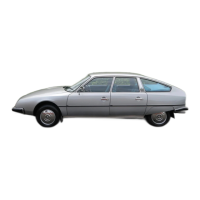Supplement
6..
.'3
'-r
(-D
,.O
..C
,';
tis '+7
'y"
(G_
'T7
I?- .N-
°"L
.s' a-+
P-`
Uti
.--
ter.
I°"U°W
OPERATION
N° MÅ. 390-0 : Lieck/
fh
/i/raujjc
cw»on(?iL
on f/)(
Op. MÅ. 390-0
3
Manual
steering .ehic/es
6.
Checking
the safety valve:
a) Remove safety
valve
fixing screw
(1).
-
b
}
Remove from
safety valve
2
supply pipe
f
or front
suspension
(2),
-
supply
pipe for rear
suspension
(3).
c)
Plug
openings
of
safety
valve
(p!ugs E
-
H
d)
Tighten pressure
regulator bleed
screw
and
,
start
engine.
e)
Disconnect
rubber overflow
return
pipe
and
0
watch aperture «a»
of
safety valve.
-
1/
ibere is
sligbt aPnouil of
s/e
-
safe! al,'e is
« in good order «.
If there is a discharge
of Jinid
the
sUetv
-
a1n
must
be replacc'd.
f
)Slacken pressure regulator
bleed screw.
Connect overflow return
pipe to safety
valve.
L
Secure safety
valve
(
screw
1 »).
7. Checking
the
safety valve slide-valve
a) Remove
plug from
rear suspension ouUet on
safety valve at
«
b
b
}
Disconnect contact breoker lead on coil
and
tum engine
using
starter fluid should
start
to run through the opening
«
d
«
when pressure
reaches
110 to 130 bars
(1585
to 1885
ps)
-
c)
Slacken pressure
regulator
bleed
screw.
Connect contact breaker lead.
d)
Plug safety
valve opening
«
b
» (plug
E
8.
Checking
the hydroulic brake
control
a) Tighten
pressure regulator bleed screw.
b)
Start up engine.
Whn cut-out
takes
place wait a few
secorids
for the
pressure
to stabilize.
Stop
engine.
Watch
pressure
gauge and
note the pressure
drop in the next 3
minutes.
If
pressure
drop
exceeds
10 bar5(
145
psi
)
repeat the test.
Tf the result is the same, the
brake control
valve is
defective
: change it.
PDF compression, OCR, web-optimization with CVISION's PdfCompressor

